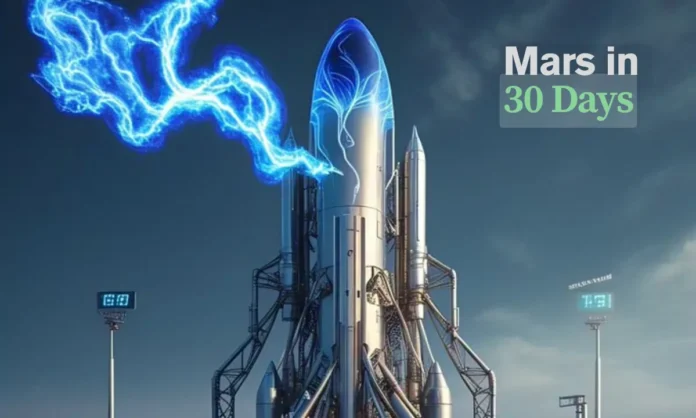Summary
- Russian scientists at Rosatom unveil a plasma propulsion system capable of 100 km/s speeds, cutting Mars travel time to just 30 days.
- The engine uses electromagnetic fields and hydrogen ions for continuous thrust, unlike traditional rockets.
- A prototype is already under testing, with plans for a flight-ready model by 2030.
A Soviet-Sized Leap: Russia’s Revolutionary Plasma Engine and the Future of Mars Missions
In a bold move that could rewrite the future of interplanetary travel, Russian scientists have unveiled a plasma propulsion engine they claim could cut the journey to Mars down to just 30 days. Developed by the Troitsk Institute under Rosatom, the experimental engine uses cutting-edge plasma physics to outperform current systems like SpaceX’s Starship, and promises to be a game-changer in deep-space exploration.
Announced in early April, the breakthrough brings Russia back into the center of space propulsion innovation, and it comes at a time when the global space race is shifting gears—from satellite deployment to planetary colonization.
Russian Scientists Unveil Plasma Engine That Could Reach Mars in 30 Days. This new engine developed by scientists at Rosatom’s Troitsk Institute.Instead of relying on combustion to generate thrust, it uses EM fields to accelerate charged hydrogen ions to speeds of 100 km/s pic.twitter.com/Yt7Nm5tPrF
— Varun Karthikeyan (@Varun55484761) April 6, 2025
Not Just Rocket Science: How the Plasma Engine Works
- Uses electromagnetic fields to accelerate charged hydrogen ions to 100 km/s (360,000 km/h).
- Offers continuous thrust unlike traditional rockets that burn and coast.
- Reduces exposure to cosmic radiation by minimizing travel time.
Unlike traditional chemical rockets, which rely on combustion and produce short bursts of high energy, Russia’s new plasma engine is designed for long-distance acceleration. The innovation lies in its steady propulsion model—small but persistent thrust over time, allowing a spacecraft to gain momentum continuously throughout its journey.
The physics is elegant: hydrogen ions, the lightest and most abundant particles in the universe, are electrically charged and accelerated by electromagnetic fields. The result is sustained propulsion at speeds conventional systems can only dream of.
Testing Phase: From Vacuum Chambers to Mars-Ready Blueprints
- A working prototype has been built and tested in vacuum chambers simulating space.
- The engine produces 300 kW of power and can operate for 2,400 hours, long enough for a round trip to Mars.
- Functions in pulse-periodic mode, with testing rigs measuring 4 meters wide and 14 meters long.
Currently, the engine is undergoing rigorous tests in a custom-built vacuum environment meant to mimic real-world space conditions. Engineers are studying its thermal profile, magnetic field integrity, and wear resistance. The goal is to develop a space-ready model by 2030, potentially positioning Russia as the first nation to deliver continuous plasma-driven interplanetary travel.
However, it’s important to note that the engine won’t replace chemical rockets altogether. Traditional boosters will still be required to exit Earth’s gravity well. The plasma engine will activate only once in orbit, providing the long-haul propulsion needed for deep-space missions.
Hydrogen: The Universe’s Most Abundant Fuel
- Hydrogen is used as the primary propellant, offering high efficiency and low heat generation.
- Could potentially be harvested in space, allowing for sustainable refueling.
- Produces less thermal stress, increasing engine longevity.
Hydrogen is a near-perfect propellant for this new form of space propulsion. It is light, efficient, and ubiquitous in the cosmos. By focusing on hydrogen, Russian scientists are aiming to make the engine not just fast, but viable for long-term missions and in-situ resource utilization.
The use of hydrogen also reduces the thermal footprint, meaning engine components are less likely to overheat or degrade under stress, a common issue in traditional ion thrusters.
A New Space Race: Starship vs. Russia’s Plasma Dream
While Elon Musk’s SpaceX Starship remains the most visible effort in human spaceflight to Mars, the emergence of a Russian plasma engine throws down a bold challenge. Starship’s brute force may carry payloads, but plasma’s efficient acceleration offers a fundamentally different path.

This distinction could become the defining difference in 21st-century space missions. While Starship’s hardware is focused on payload mass and reusability, Russia’s plasma engine introduces speed, sustainability, and scale to the mission profile.
Final Verdict: Is This the Dawn of 30-Day Mars Missions?
The dream of reaching Mars in a month has long felt like science fiction. But if Russia’s plasma propulsion system lives up to its potential, that fiction could soon become fact. The combination of hydrogen-based ion acceleration, continuous thrust, and nuclear-powered operation sets the stage for a new era of space travel—faster, smarter, and more future-ready than ever before.
As nations jostle for influence beyond Earth, Russia may have just made its loudest post-Soviet statement yet: the future of deep space might be plasma-powered.


